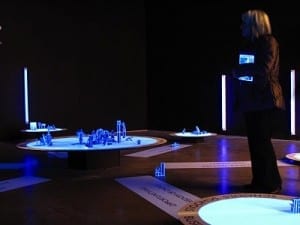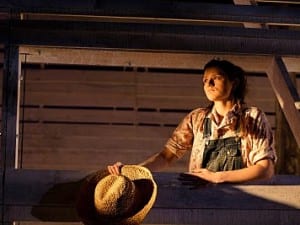Review by Colin Herd
Jean-Marc Bustamante, who represented France at the Venice Biennale in 2003, began his career as an assistant to the renowned fashion photographer, filmmaker and artist William Klein. You’d never guess it, though, from a visit to this career-spanning show at the Fruitmarket Gallery. Walking around the still, monumental, people-less works that make up Dead Calm, the connection feels surprising and counterintuitive. Klein’s career has been devoted to photographing and filming myriad people in his vivid New York and Paris crowd scenes, motion-blurred street photography and boisterous satirical fashion films. The representation of people is at the core of Klein’s art; his work teems and throngs with faces and bodies, often caught in some kind of action or movement. In stark contrast, the work of Jean-Marc Bustamante tends towards unpopulated, unremarkable spaces: large-scale photographs of what you might call anti-landscapes, and abstract sculptures made from industrial materials. Rather than the crowds of major cultural centres, it’s the neglected spaces and unnoticed details that Bustamante subtly interrogates, and in the impersonal materials and processes he makes use of that his work achieves a quiet, cool magic.
The exhibition begins with a number of photographs from the series with which Bustamante made his name: Tableaux. Shot in dusty, unglamorous, empty landscapes, they often feature construction-works and man-made pits. The viewer’s attention is drawn to the spaces in between and underneath half-completed brickwork and dug-out swimming pools. They are insouciantly mundane, but there’s also a stifling emptiness and stillness, evoking a kind of burial ground. The photographs have an extreme lack of specificity- no clue is given as to the photographs’ location- and this is part of their charge and interest. They have an almost flirtatious aura about them, a dynamic of equal parts putting forth and holding back. There’s also something architectural about these large photographs, and even something sculptural as the eye has to confront and navigate the dimension, shape, and space of their construction and material.
These early photographs are being shown alongside more recent sculptural works. Bac à sable 1 (1990) is a large concrete sand-pit that sits solid and monumental in the middle of the room. A wooden ridge runs around the edge of the pit, framing it like a picture. There is even something in the grainy texture of the tightly-packed sand that suggests the ‘noise’ in a blurred photograph. Again, of course, the pit suggests a grave of sorts, but this time its dimensions are roughly that of a double bed, so there’s that resonance too, the ripples of the sand suddenly inviting, like a ruffled duvet. This domestic suggestion echoes and extends in Interieur (1988), a sculpture in the adjacent room. Looking part like a bed and part like a coffee table, it consists of two wooden tabletops (as the catalogue states, a diptych, of sorts), with a carved hatching design, placed on a steel base.
In the upstairs gallery, Fruitmarket are showing a generous selection of recent paintings and sculpture using plexiglass. With a palette of dazzling, coruscating colours and a crudeness of line and shape that recalls Matisse’s late cut-outs, Bustamante’s ink-works draw on every ounce of the natural slickness and coolness of the plexiglass surface. The real fascination of these pieces lies in the gaps between the ink where the transparent plexiglass shines through, and the shadow of the ink is cast on the wall behind. The images themselves recall landscape-paintings, edging towards chromatic abstraction. There’s an interesting tension between the more expected sensation of looking through the “window” at a landscape, and studying the contours of the ink on the surface of the plexi-. It’s as if you can’t see through the window for the landscape in it. The lines and shapes of the drawing itself tend to be angular, recalling the swipes of an eraser, or a window-cleaning squeegee. A neighbouring large sculptural work, Landscape Table (2008) sees a conglomeration of tree-like pillar candles on a plexi- and steel table with a curvy cut hole in the centre, like a lake. The opening also recalls the foundational excavated spaces of the Tableaux downstairs. As in the sand-pit sculpture downstairs, the viewer experiences this landscape as a kind of horizontal ‘picture’ to be viewed from above. Adding another directional plane to the experience, across the room a piece of plexiglass, shaped like the missing piece from the hole, hangs vertically down from a steel post, like a wet flag on a windless day, or a flowing robe from the hook on a bathroom door. As with some of the earlier abstract sculptures downstairs, there’s even something vaguely human about the shape when viewed vertically.
It’s details and whispers like these that give the show a unity and fluidity between the early and recent work, contextualizing the bold lightness of touch and sense of humour of these most recent pieces within Bustamante’s artistic concerns and obsessions. Dead Calm is an intriguing and beautiful show, proving that old adage accurate: plexi really is sexy.
Dead Calm continues at Fruitmarket Gallery, Edinburgh until 3rd April.
Jean-Marc Bustamante Dead Calm (installation view), 2011
Courtesy the artist, Thaddaeus Ropac Gallery and Timothy Taylor Gallery
Photo: Gautier Deblonde Copyright: The Fruitmarket Gallery





